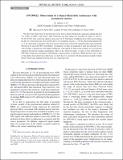GW190412: Observation of a binary-black-hole coalescence with asymmetric masses
Author(s)
LIGO Scientific Collaboration; Virgo Collaboration; Barsotti, Lisa; Biscans, Sebastien; Biscoveanu, Sylvia; Buikema, Aaron; Demos, Nicholas; Donovan, Frederick J; Eisenstein, Robert Alan; Evans, Matthew J; Fernandez Galiana, Alvaro-Miguel; Fritschel, Peter K; Ganapathy, Dhruva; Gras, Slawomir; Hall, E. D.; Haster, Carl-Johan; Huang, Y.; Isi Banales, Maximiliano S; Katsavounidis, Erotokritos; Knyazev, E.; Lane, B. B.; Lanza Jr, Robert K; London, L. T.; MacInnis, Myron E; Mansell, Georgia; Mason, Kenneth R; Massinger, Thomas J.; Matichard, Fabrice; Mavalvala, Nergis; McCuller, Lee P; Mittleman, Richard K; Mo, Geoffrey; Ray Pitambar Mohapatra, Satyanarayan; Ng, Kwan Yeung; Noh, M.; Shoemaker, David H; Sudhir, Vivishek; Tse, Maggie; Vitale, Salvatore; Weiss, Rainer; Whittle, Christopher Mark; Yu, Hang; Yu, Haocun; Zucker, Michael E; ... Show more Show less
DownloadPublished version (4.793Mb)
Publisher with Creative Commons License
Publisher with Creative Commons License
Creative Commons Attribution
Terms of use
Metadata
Show full item recordAbstract
© 2020 authors. Published by the American Physical Society. Published by the American Physical Society under the terms of the "https://creativecommons.org/licenses/by/4.0/"Creative Commons Attribution 4.0 International license. Further distribution of this work must maintain attribution to the author(s) and the published article's title, journal citation, and DOI. We report the observation of gravitational waves from a binary-black-hole coalescence during the first two weeks of LIGO's and Virgo's third observing run. The signal was recorded on April 12, 2019 at 05â¶30â¶44 UTC with a network signal-to-noise ratio of 19. The binary is different from observations during the first two observing runs most notably due to its asymmetric masses: A ∼30 M⊙ black hole merged with a ∼8 M⊙ black hole companion. The more massive black hole rotated with a dimensionless spin magnitude between 0.22 and 0.60 (90% probability). Asymmetric systems are predicted to emit gravitational waves with stronger contributions from higher multipoles, and indeed we find strong evidence for gravitational radiation beyond the leading quadrupolar order in the observed signal. A suite of tests performed on GW190412 indicates consistency with Einstein's general theory of relativity. While the mass ratio of this system differs from all previous detections, we show that it is consistent with the population model of stellar binary black holes inferred from the first two observing runs.
Date issued
2020Department
LIGO (Observatory : Massachusetts Institute of Technology); MIT Kavli Institute for Astrophysics and Space Research; Massachusetts Institute of Technology. Department of PhysicsJournal
Physical Review D
Publisher
American Physical Society (APS)